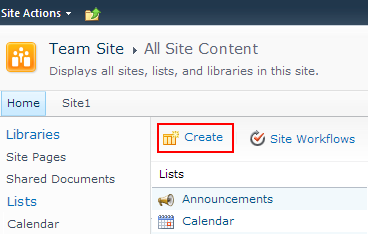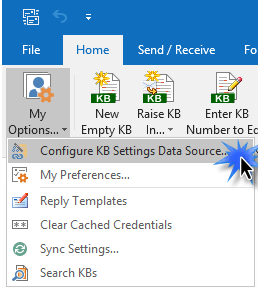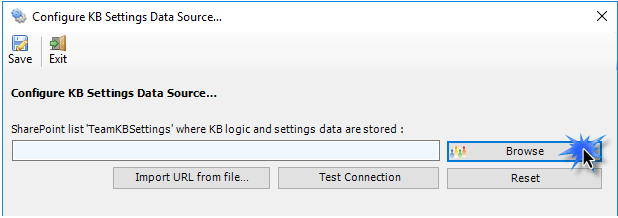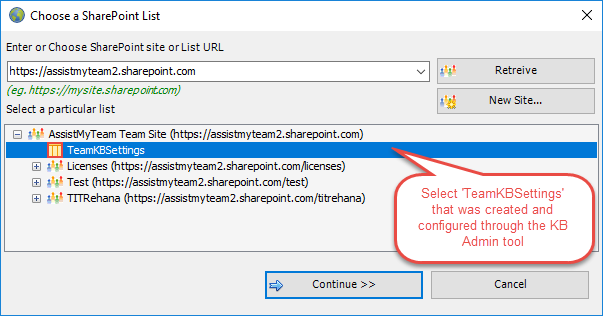Home > Products > Knowledge Base Addins > Installation Guide – Team Edition (SharePoint)
Install Steps
It typically takes not more than 2 minutes to perform an administrative install, and just less than a minute to make a simple Client install to each user’s system.
Team Knowledgebase consists of two separate installs – Admin and User. The admin installation is to be done by the manager to configure the team specific KB settings such as defining drop down lists, choosing destination SharePoint lists that store the KB articles and mapping fields between Outlook and SharePoint.
(Note that, the Admin install already consists of the User tool too, so you don’t need to install the User tool separately.)
There are two different setup types:
For ‘Per User Installation’ (ideal for standalone single user/workstation)
TeamKnowledgebaseSPSetups_x86.zip (for 32-bit Outlook 2010, 2013, 2016, 2019)
TeamKnowledgebaseSPSetups_x64.zip (for 64-bit Outlook 2010, 2013, 2016, 2019)
For ‘Per Machine Installation’ (ideal for installing on Citrix and Terminal Servers)
TeamKnowledgebaseSPSetups_x86_Citrix.zip (for 32-bit Outlook 2010, 2013, 2016, 2019)
TeamKnowledgebaseSPSetups_x64_Citrix.zip (for 64-bit Outlook 2010, 2013, 2016, 2019)
The downloaded zip file contains 3 files: TeamKBAdminSPSetup_xXX.exe, TeamKBUserSPSetup_xXX.exe and
VersionInfo.txt where ‘xXX’ can be either x86 (32bit Outlook) or x64 (64bit Outlook)
Extract these file contents to a file folder. It is recommended that you place the setup files on a shared network folder, such that all users can have access to it, and ease the installation and upgrade process.
NOTE: Per User Installation and Per Machine Installation
In Per User Installation, both the Admin and Client installs are performed 100% on the local system and nothing is installed on your Exchange or Windows Server. Further, this install is intended to serve only the current logged on user of the system/workstation and will be installed under the user’s application data folder (instead of Programs Files folder) and no elevated permission is required (This is known as per user installation). So, there won’t be a prompt from UAC to allow this install unless you change the install directory to say, Programs Files which will warrant an elevated permission/UAC prompt. If the same system is used by multiple technicians, each user needs to install add-in on their profile with the default installation folder location.
Per Machine Installation: If you have the need to have a single install that serves all users of the system (i.e., per machine installation, which technically means the files will be installed under Program files folder and the add-in will be registered under HKEY_LOCAL_MACHINE registry hive rather than HKEY_CURRENT_USER), download the Citrix/Terminal Server version of the setups to perform a per machine installation.
Part I: Admin add-in Part II: User Add-in
Part-I: Admin Installation and Configuration
The managerial installation has to be performed by the administrator/manager before the User tool is installed on every other systems.
The Admin setup is of two different types – one each for 32-bit Outlook and 64-bit Outlook
For Per User Installation:
TeamKBAdminSPSetup_x86.exe (for 32-bit Outlook 2010, 2013, 2016, 2019)
TeamKBAdminSPSetup_x64.exe (for 64-bit Outlook 2010, 2013, 2016, 2019)
For Per Machine Installation:
TeamKBAdminSPSetup_x86_Citrix.exe (for 32-bit Outlook, 2010, 2013, 2016, 2019)
TeamKBAdminSPSetup_x64_Citrix.exe (for 64-bit Outlook 2010, 2013, 2016, 2019)
There are three (3) sections in Administrative installation:
A) Files Installation
Step 1. Run the TeamKBAdminSPSetup_xXX.exe to start the installation. Click ‘Next‘ to Continue. If Outlook 2010 or later is not installed, the setup wizard will not be able to proceed. Please also ensure Outlook is shutdown (if already running or active in the task manager) as the setup has to install an Outlook add-in.

Step 2. Select the appropriate destination folder where the application files will be installed. If you change the default folder path, please make sure you have appropriate permission. (Note: by default, it will be installed under your application data folder)

Step 3. Click ‘Next’ to continue with the files extraction. It just takes a few minutes to complete the whole copying process

Step 4. Click ‘Finish’. This ends the files installation process in your system.

B) SharePoint Connection & Configuration
The next step is to choose a SharePoint site, under which, a new list titled ‘TeamKBSettings‘ would be created, to store the metadata and mapping settings as performed by the administrator.
Why store the KB settings in a special SharePoint list?
Because your staffs can be scattered in different geographical locations, and might not have access to the company’s local network remotely, using a network database or shared folder won’t be feasible. Instead, in Team KB system, the KB configuration and settings data are stored in a special SharePoint list (having the name ‘TeamKBSettings‘) which is accessible to all staffs, on the local network, WAN or via the WWW.
In short, this list will act as a KB Settings data source, and other users with their IssTeam KB User add-in would connect to it.
Start Outlook and you would be automatically prompted with the ‘KB Settings Data Source…’ panel. If it is not visible, you can invoke it from Outlook > Team KB toolbar > Team Settings menu > Configure KB Settings Data Source…

To specify a SharePoint site, click the ‘Browse…’ button.

This would allow you to enter the URL of the SharePoint. When entering the URL, always use the parent site URL in the format http://mySharePointsite. And click ‘Retrieve’ to show all available sub-sites and lists.

Select the particular site to which the Settings list would be created, and then click ‘Confirm’.
Very Important! Your permission to the SharePoint site: Make sure that you have ‘Full Control’ permission over the SharePoint site so that Team KB add-in can create the ‘TeamKBSettings’ list automatically.
And then select the particular site under which the KB settings would be stored. You can also choose to create a new sub-site on the fly by clicking the ‘New Site…’ button and select it. When you click ‘Confirm’, Team KB Add-in will automatically create and configure a new SharePoint list titled ‘TeamKBSettings’ under the site. And then any settings/drop down lists you defined from Team KB Admin add-in in Outlook would be saved in this repository.
Login prompt dialog to SharePoint site
If the SharePoint site uses the NTLM or windows authentication, the add-in will use the default credential to connect to the SharePoint.

However, for form based or claimed based authentication (for example, Office 365 SharePoint online), it may prompt you (and other users) to enter their credential.
Check ‘Remember’ so that Team KB add-in can use the same credential to logon to the SharePoint site in subsequent connection.
You can also specify the authentication mode that is used by your SharePoint to allow connection to it. For instance, if your SharePoint is configured for Windows authentication, choose ‘NTLM’. If your SharePoint site is secured with ADFS, you can also specify the STS site URL under the ADFS server to get the authorization token.
If the site uses a form-based authentication, then choose ‘Forms’ whereas if it uses a claimed based authentication (for Office 365 SharePoint Online), choose ‘Office 365’.
NOTE FOR OFFICE 365: If your SharePoint admin has set up 2-step verification or multi-factor authentication (MFA) on your Office 365 account, and you’re trying to connect Team KB add-in to your SharePoint Online site, you may get the following error message in the login dialog box of the add-in if you use your Office 365 account password. The Sign-in name or password does not match one in the Microsoft account system. Refer to this KB article on how to resolve it |

Once you click ‘Save’, this KB settings list will be automatically created in the chosen SharePoint site, when the manager configures the admin tool the first time. And then any settings/drop down lists you defined from Team KB Admin add-in in Outlook would be saved in this repository.
Make sure that you have provided the chosen SharePoint site URL (e.g. http://company.sharepoint.com/ in the above example) to all users who have or will install the User tool, as when user starts Outlook, the Team KB add-in will prompt the user to specify the SharePoint site where the ‘TeamKBSettings’ list is located. And only then the add-in would automatically connect to the admin specified SharePoint site to retrieve the KB logic and settings configuration to the local system.
What SharePoint permissions are required for KB Users?
All KB users should have at least ‘Contribute’ permission the SharePoint list ‘TeamKBSettings’ as well as to all other SharePoint lists that are chosen as the KB repositories.
You can use any SharePoint version starting with SharePoint 2010 to the latest SharePoint 2016. You can also use Office 365 SharePoint Online too.
C) Choose SharePoint KB Lists
Before you and other users can start generating KB articles from Outlook to SharePoint or using them in Outlook from SharePoint, the manager needs to choose the destination SharePoint lists that store the KB articles and link them up with Team KB Admin Add-in. Once linked, you and other users would be able to use KB articles from SharePoint in Outlook to reply to emails, as well as generate new KB articles in one of the chosen SharePoint list using information and content from emails in Outlook.
To configure a new SharePoint list and map fields with the Outlook mails, go to Team Settings menu > ‘Configure SharePoint KB Lists’.

Here is a listing of all SharePoint lists containing KB articles that are linked and configured. These chosen SharePoint lists would be deployed to all users in their Outlook (i.e., individual user would be able to generate a KB from an email to one of these SharePoint list as well as use it from SharePoint to reply to emails in Outlook).

To configure a new SharePoint KB list and perform fields mapping, click ‘New Mapping…’ button. You will then be prompted to enter the SharePoint site URL, and it would allow you to choose a SharePoint list.

You can choose re-use existing SharePoint lists or create new one for this purpose. Ideally, we recommend that the SharePoint lists you will choose for used with Team KB add-in were derived from the inbuilt ‘Custom List’ template in your SharePoint.

For instance, you can create a new list (e.g., KB) based on the ‘Custom List’ template below:

And then choose this newly created SharePoint list (e.g. KB) or any other existing lists from the mapping tool and click ‘Confirm’.

Instead of creating the new site/list in the SharePoint using your web browser, you can also choose to create – new site or list directly from the add-in.
![]() New Site – Create a new site directly under the chosen parent site to be used exclusively for Team KB add-in. By default, the site will be created as a blank site, unless a different site template is specified.
New Site – Create a new site directly under the chosen parent site to be used exclusively for Team KB add-in. By default, the site will be created as a blank site, unless a different site template is specified.

![]() New List – You can choose to create a new list directly under the chosen site. By default, the list would be created using the ‘Generic List’ (custom list) template available in your SharePoint. However, you can change the template from the drop down.
New List – You can choose to create a new list directly under the chosen site. By default, the list would be created using the ‘Generic List’ (custom list) template available in your SharePoint. However, you can change the template from the drop down.

After choosing a destination SharePoint list (either by creating a new one, or by selecting an existing list), you can proceed to start mapping the fields between Outlook and SharePoint.
Through the mapping tool, you can choose which fields from the emails in Outlook are to be extracted and published to the SharePoint KB list, and perform the mapping between these chosen fields of the emails to that of the SharePoint KB list.

A mapping is nothing but an association between an Outlook field (e.g., subject of the mail item) to a specific SharePoint list field (e.g., Title). You have complete control over which data goes to the SharePoint list from Outlook. In the mapping dialog box (above), the first column lists all the email fields as available in Outlook. The second column displays the data type of the field. In the last column, there is a drop down list on each row, consisting of all available SharePoint fields. Just simply choose a SharePoint field from the drop down box to map it to the corresponding Outlook field. For example, in the screenshot above, Outlook field ‘Problem Category’ is mapped to SharePoint field ‘ProblemCategory’.
You can choose to auto create the required fields in the SharePoint list as well as auto-map the fields between the Outlook and SharePoint.
![]() For mandatory unmapped fields – Click this option under the ‘Auto Create & Map fields’ menu to create the mandatory KB fields in the chosen SharePoint list on the fly and automatically complete the mapping. Mandatory fields are marked/colored in light red. The following fields are mandatory to complete the mapping – Subject, Solution, Problem Category, Problem Type, Not Ready For Use.
For mandatory unmapped fields – Click this option under the ‘Auto Create & Map fields’ menu to create the mandatory KB fields in the chosen SharePoint list on the fly and automatically complete the mapping. Mandatory fields are marked/colored in light red. The following fields are mandatory to complete the mapping – Subject, Solution, Problem Category, Problem Type, Not Ready For Use.
![]() For all unmapped fields – Click this option under the ‘Auto Create & Map fields’ menu to create all the KB fields that have not been mapped yet in the chosen SharePoint list and complete the mapping automatically. If the chosen SharePoint list have any matching existing fields, instead of creating new ones, the add-in will try to use them to map with the KB fields. For instance, if the chosen SharePoint list was created based on the ‘Custom List’, the list already contains predefined fields such as Title, Description etc.
For all unmapped fields – Click this option under the ‘Auto Create & Map fields’ menu to create all the KB fields that have not been mapped yet in the chosen SharePoint list and complete the mapping automatically. If the chosen SharePoint list have any matching existing fields, instead of creating new ones, the add-in will try to use them to map with the KB fields. For instance, if the chosen SharePoint list was created based on the ‘Custom List’, the list already contains predefined fields such as Title, Description etc.
![]() For the following fields – Click this option under the ‘Auto-Create & Map fields’ menu to choose specific KB fields of interest that will be auto-created in the chosen SharePoint and mapped automatically.
For the following fields – Click this option under the ‘Auto-Create & Map fields’ menu to choose specific KB fields of interest that will be auto-created in the chosen SharePoint and mapped automatically.

Optionally, to have finer control, you can also manually create new fields in the chosen destination SharePoint list and map with the KB outlook fields.
Create New SharePoint Field – on the fly
In the drop down list of the SharePoint field, you will also notice that there is an item ‘[NEW LIST FIELD]’. You can select this item to create a new field in the particular SharePoint list, directly from this mapping tool, so that you can map the specific Outlook field to this new SharePoint field, without requiring you to create it in your SharePoint site.

Specify a field name that you would like to appear in the SharePoint list. Only input valid characters and avoid using special characters such as symbols.

The new SharePoint field will have the same data type as that of the corresponding Outlook field.

NOTE: Those fields with light green background color are custom fields which you can define in Outlook > Team Settings > Custom Fields panel so that you can have additional fields to best describe and add metadata on the KB article.
If you have added multiple SharePoint KB lists in Team KB add-in, you will notice that the ‘Raise KB in‘ drop down menu shows all of them. You and other users can then simply choose the destination SharePoint list to which a new KB will be raised from the selected email in Outlook.

Through the Team KB Admin console, you can define, map and link any number of SharePoint lists from multiple sites so that, your users can have a choice to choose a particular SharePoint list of interest to which new KB from their emails can be raised from their Outlook, or more importantly, choose an existing KB article from one of the relevant SharePoint list to reply to an email in Outlook.

After these 3 steps, you can start installing the Team KB User add-in to the systems of your other staffs. You can also install the Team KB Admin add-in on other systems as well if the particular user has the need to perform administrative tasks.
NOTE: There are other administrative configurations that you would need to undertake. These options are available in the ‘Team Settings…’ drop down menu of the Team KB Admin toolbar or ribbon in Outlook.
For more references and helps on performing these administrative configurations, refer to the PDF Help Manual, which can be invoke from the Outlook > Team KB toolbar or ribbon > Help > Help Topics.
Part-II: Client Installation and Configuration
This install is meant for users who would be accessing KB articles in Outlook from SharePoint and reply to emails with the contents and attachments of the chosen KB article. Before you install the User tool, make sure your administrator has already configured the KB settings and configurations on a SharePoint site with the Team KB Admin tool. And take note of the SharePoint parent site URL which you will need to feed to the Team KB User Add-in once it is installed. This is required because you will be asked to specify the SharePoint site URL once you start Outlook (for the purpose of linking up the User add-in tool with the ‘TeamKBSettings’ SharePoint list).
The User setup is of two different types – one each for 32-bit Outlook and 64-bit Outlook:
For Per User Installation:
TeamKBUserSPSetup_x86.exe (for 32-bit Outlook 2010, 2013, 2016, 2019)
TeamKBUserSPSetup_x64.exe (for 64-bit Outlook 2010, 2013, 2016, 2019)
For Per Machine Installation:
TeamKBUserSPSetup_x86_Citrix.exe (for 32-bit-Outlook 2010, 2013, 2016, 2019)
TeamKBUserSPSetup_x64_Citrix.exe (for 64-bit-Outlook 2010, 2013, 2016, 2019)
(Note: The User add-in and functionality is already a subpart of Admin Install and is not required to be installed if the admin tool is already installed on the system).
Step 1. Run TeamKBUserSPSetup_xXX.msi/exe to start the installation. Click ‘Next’ to Continue. If Outlook 2010 or later is not installed, the setup wizard will not be able to proceed.

Step 2. Select the appropriate destination folder where the application files will be installed. If you change the default folder path, please make sure you have appropriate permission.

Step 3. Click ‘Install’ to continue the files extraction. It may take a few minutes to complete the whole copying and registration process.

Step 4. Click ‘Finish‘ to end the installation wizard.

Now start Microsoft Outlook. If the Team KB User add-in installation was successful, you will see a toolbar or ribbon with the title ‘Team Knowledgebase’ toolbar in Outlook.
SharePoint Connection
Once installed, the user will be prompted to specify the KB Settings Data Source, which is nothing, but a special SharePoint list having the title ‘TeamKBSettings‘, which was configured previously by your KB administrator. If the ‘KB Data Source’ panel does not show up, you can invoke from Outlook > Team KB toolbar > My Options > Configure KB Settings Data Source…

Click ‘Browse…‘ to specify the SharePoint site where the ‘TeamKBSettings’ list is located.

Enter the SharePoint URL site to show all available sub-sites and lists. If your KB administrator had already configured Team KB System with the admin tool, there would be a list ‘TeamKBSettings‘ that stores KB configurations including destination SharePoint lists and their corresponding mapping settings. Select that list to maintain a permanent link between the User add-in and the SharePoint KB data source.

The SharePoint list chooser dialog box, where it shows all the available sub-sites and their lists displayed in hierarchical order.

Now, click the Save button, to confirm the connection. Team KB User add-in is now ready to access KB articles stored in your SharePoint lists from within Microsoft Outlook for the purpose of replying emails with the contents and attachments of a chosen KB article.
Login prompt dialog to SharePoint site
If the SharePoint site uses the NTLM or windows authentication, the add-in will use the default credential to connect to the SharePoint.

However, for form based or claimed based authentication (for example, Office 365 SharePoint online), it may prompt you (and other users) to enter their credential.
Check ‘Remember’ so that Team KB add-in can use the same credential to logon to the SharePoint site in subsequent connection.
You can also specify the authentication mode that is used by your SharePoint to allow connection to it. For instance, if your SharePoint is configured for Windows authentication, choose ‘NTLM’. If your SharePoint site is secured with ADFS, you can also specify the STS site URL under the ADFS server to get the authorization token.
If the site uses a form-based authentication, then choose ‘Forms’ whereas if it uses a claimed based authentication (for Office 365 SharePoint Online), choose ‘Office 365’.
NOTE FOR OFFICE 365: If your SharePoint admin has set up 2-step verification or multi-factor authentication (MFA) on your Office 365 account, and you’re trying to connect Team KB add-in to your SharePoint Online site, you may get the following error message in the login dialog box of the add-in if you use your Office 365 account password. The Sign-in name or password does not match one in the Microsoft account system. Refer to this KB article on how to resolve it. |
What SharePoint permissions are required for KB Users?
All users should have at least ‘Contribute’ permission the SharePoint list ‘TeamKBSettings’ as well as to all other SharePoint lists that are chosen as the KB repositories. And when users with the Team KB User add-in starts Outlook, the add-in would automatically connect to the admin specified SharePoint site and would retrieve the KB logic and settings data to the local system.
If your administrator have added and linked multiple SharePoint KB lists in Team KB add-in, you will notice that the ‘Raise KB in’ drop down menu shows all of them. You can now simply choose the destination SharePoint list to which a new KB will be raised from the selected email in Outlook.

You also have a choice to pick an existing KB article of interest or relevant from one of the configured SharePoint list to reply to an email in Outlook.

NOTE: For more references and helps on working of Team KB and using KB articles in Outlook from SharePoint, refer to the PDF Help Manual, which can be invoke from Outlook > Team KB toolbar or ribbon > Help > Help Topics.
